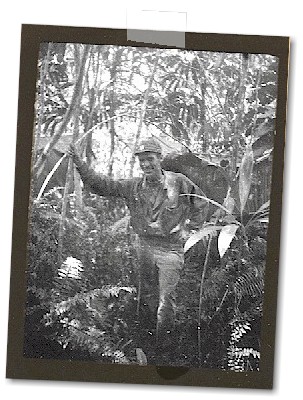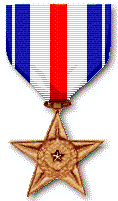|

 When
"F" Co got to 28-D probably an hour after the jump, my platoon was in the
lead. Bailey had me my place two squad platoon take 4 men from the 1st
squad, the 2nd squad, and the 3rd squad in a perimeter around his new CP.
The 3rd platoon joined in a defense back to east to join with D Co. When
"F" Co got to 28-D probably an hour after the jump, my platoon was in the
lead. Bailey had me my place two squad platoon take 4 men from the 1st
squad, the 2nd squad, and the 3rd squad in a perimeter around his new CP.
The 3rd platoon joined in a defense back to east to join with D Co.
The terrain had been thoroughly mowed by bombs and shells, and I could see
much the number 2 gun port plainly. Going up stairs I could see the steps
going up from the gun platform to the top of the battery wall facing the
sea, I came down and told Bailey I was going out toward that battery (I
would learn the name shortly when I went there). He said OK.
Just before I made the turn bringing me behind
the battery, I saw a dead officer tagged with an Emergency Medical Tag. It
was filled out. Under injury was entered "GSW" Under prognosis the entry
entered was "Death." Captain Spicer had made out his own EMT before he died.
.
I have no memory of a cigarette. Not only was he not wearing a Red Cross
emblem on his helmet, but I never saw a 503rd medic wearing one. The talk
was that Japs used them for choice targets. Many of our medics carried .45's
and some carbines.
As I said, I walked further out into the flat yard between the battery and
the berm. I could see the length of the rear of the long battery. Then some
one walked out of the shadows near the shell loading area of the two story
magazine. I pushed the safety off my newly acquired M-1 (the one I acquired
after smashing mine in the landing). But I recognized Brownie, our battalion
S-3 coming toward me.
He said the battery was empty. We walked back past Spicer's body and
discussed the EMT tag. Brownie died a couple of years ago, but we discussed
our foolishness a number of times in years since 1945. In a couple of hours
my platoon was engaged with the enemy holed up in the battery.
Later that after while engaged with the enemy the battery, we found the body
of an American GI with a carbine lying on the forward side (battery side) of
the berm. I saw no other bodies at that time.
Lt. Bill Calhoun
"F" Co.
(In the light of Calhoun's
first hand recollection, his version is to be preferred over Devlin's.)
 Captain
Emmett R. Spicer, the 462d Parachute Field Artillery Battalion's doctor, was
well known for his considerable skill as a combat surgeon and for being a
stickler when it came to filling out paperwork associated with his job.
Spicer jumped with the second lift and immediately reported to the
regimental aid station to let them know he was aboard. He then started back
to his own aid station, stopping along the way to treat a paratrooper who
had lost an eye to a tree stump upon landing. Before sending the injured
trooper on to the aid station, Dr. Spicer filled out the required battle
casualty tag and tied it to a pocket flap on the man's jacket. Captain
Emmett R. Spicer, the 462d Parachute Field Artillery Battalion's doctor, was
well known for his considerable skill as a combat surgeon and for being a
stickler when it came to filling out paperwork associated with his job.
Spicer jumped with the second lift and immediately reported to the
regimental aid station to let them know he was aboard. He then started back
to his own aid station, stopping along the way to treat a paratrooper who
had lost an eye to a tree stump upon landing. Before sending the injured
trooper on to the aid station, Dr. Spicer filled out the required battle
casualty tag and tied it to a pocket flap on the man's jacket.
Dr. Spicer continued moving toward his
battalion aid station, stopping several times to treat other wounded
troopers. Even though his helmet and armband bore the unmistakable
international Red Cross markings, he was shot through the chest by an
Imperial Marine while trying to reach a severely wounded man.
Having seen this type of wound many
times before, Spicer knew that he did not have long to live. Yet,
incredibly, he propped himself up sufficiently to fill out his own battle
casualty tag. Calmly, and with great care, he printed his name, rank, serial
number on the tag. In the block marked "Diagnosis" he carefully
printed: "GSW (gunshot wound), perforation left chest. Severe."
A patrol found the doctor's properly
tagged body a few hours after his death. Beside him lay his open first aid
kit, an empty morphine syrette, and the remains of his last cigarette.
Captain Spicer was posthumously awarded a Silver Star Medal for having saved
the lives of many men that day.
Gerard
M. Devlin
Back to Corregidor
St
Martin's Press, New York (1992)
(out of print)
(Those who knew "Doc" Spicer, particularly
Arlis Kline, swear that 'the remains of his last cigarette' could not be
true as the Doc was a staunch non-smoker.)
|
![]()